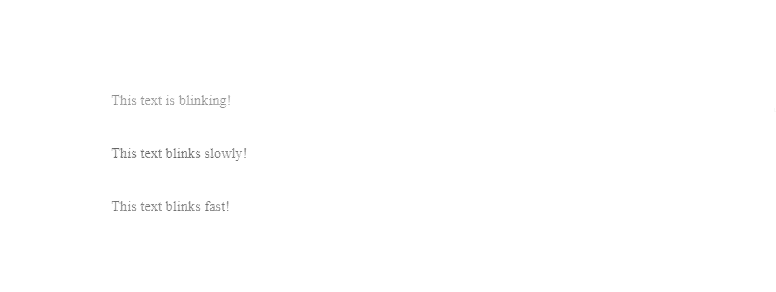How to Create Flashing/Blinking Text Using HTML and CSS
Creating flashing or blinking text can be a useful way to draw attention to specific elements on your webpage. While the <blink> tag was once a simple solution, it's now deprecated and not supported by most modern browsers. Therefore, we'll explore the recommended approach using CSS animations.
Why CSS Animations?
CSS animations offer a more robust and flexible way to achieve the blinking effect. They provide better control over timing, speed, and other visual aspects compared to the deprecated <blink> tag.
Method 1: Using opacity and animation
This is the most common and generally preferred method. It involves animating the opacity property of the text element between 0 (fully transparent) and 1 (fully opaque).
HTML (index.html):
<!DOCTYPE html>
<html>
<head>
<title>Blinking Text</title>
<link rel="stylesheet" href="style.css">
</head>
<body>
<p class="blink">This text is blinking!</p>
<p class="blink-slow">This text blinks slowly!</p>
<p class="blink-fast">This text blinks fast!</p>
</body>
</html>CSS (style.css):
.blink {
animation: blinker 1s linear infinite; /* Adjust timing as needed */
}
.blink-slow {
animation: blinker 2s linear infinite; /* Adjust timing as needed */
}
.blink-fast {
animation: blinker 0.5s linear infinite; /* Adjust timing as needed */
}
@keyframes blinker {
50% {
opacity: 0;
}
}Output:
Explanation:
@keyframes blinker: This defines the animation named "blinker." Inside,50%means at the midpoint of the animation, theopacityis set to 0, making the text invisible.animation: blinker 1s linear infinite;: This applies the "blinker" animation to the element with the class "blink."1s: The duration of one animation cycle (1 second).linear: The timing function, meaning the animation proceeds at a constant speed.infinite: Makes the animation repeat indefinitely.
- By adjusting the time value in the animation property, you can control the speed of the blink.
Method 2: Using visibility and animation
Another approach is to use the visibility property, toggling between visible and hidden.
HTML (index.html):
<!DOCTYPE html>
<html>
<head>
<title>Blinking Text</title>
<link rel="stylesheet" href="style.css">
</head>
<body>
<p class="blink">This text is blinking!</p>
<p class="blink-slow">This text blinks slowly!</p>
<p class="blink-fast">This text blinks fast!</p>
</body>
</html>CSS (style.css - alternative):
body {
padding: 100px;
}
p {
margin: 40px;
}
.blink {
animation: blinker 1s step-end infinite;
}
.blink-slow {
animation: blinker 2s step-end infinite; /* Adjust timing as needed */
}
.blink-fast {
animation: blinker 0.5s step-end infinite; /* Adjust timing as needed */
}
@keyframes blinker {
50% {
visibility: hidden;
}
}
Output:
Explanation of changes:
visibility: hidden;: This makes the element invisible without affecting the layout (it still occupies space in the document).step-end: This timing function makes the change in visibility happen instantly at the end of the 50% mark. This creates a more distinct on/off blink.
Comparison of Methods:
opacity: Creates a smoother, more fading effect.visibility: Creates a sharper, more abrupt on/off blink.
The choice between the two depends on the desired visual effect.
Important Considerations:
- Accessibility: Excessive blinking can be distracting and even harmful for users with photosensitive epilepsy or attention deficit disorders. Use this effect sparingly and consider providing a way for users to disable it.
- Alternative Visual Cues: Before resorting to blinking text, consider if other visual cues, such as color changes, bolding, or icons, could effectively convey the same information without being as potentially disruptive.
- User Experience: Blinking text can be perceived as outdated or unprofessional in some contexts. Use it judiciously and ensure it aligns with your website's overall design and purpose.
Example with JavaScript Control (For Accessibility):
To provide users with control over the blinking effect, you can use JavaScript to toggle the animation.
HTML (index.html - updated):
<!DOCTYPE html>
<html>
<head>
<title>Blinking Text</title>
<link rel="stylesheet" href="style.css">
</head>
<body>
<center>
<p class="blink" id="blinkingText">This text is blinking!</p>
<button id="toggleBlink">Toggle Blink</button>
</center>
</body>
</html>JavaScript (script.js):
const blinkingText = document.getElementById('blinkingText');
const toggleButton = document.getElementById('toggleBlink');
toggleButton.addEventListener('click', () => {
blinkingText.classList.toggle('blink-paused');
});CSS (style.css - updated):
.blink {
animation: blinker 1s linear infinite;
}
.blink-paused {
animation-play-state: paused;
}
@keyframes blinker {
50% {
opacity: 0;
}
}Output:
With this enhanced version, a button allows users to pause and resume the blinking animation, significantly improving accessibility.
Conclusion:
By using CSS animations and considering accessibility best practices, you can create effective and user-friendly blinking text effects on your web pages. Remember to use this effect sparingly and thoughtfully to avoid negatively impacting the user experience.



Comments
Post a Comment